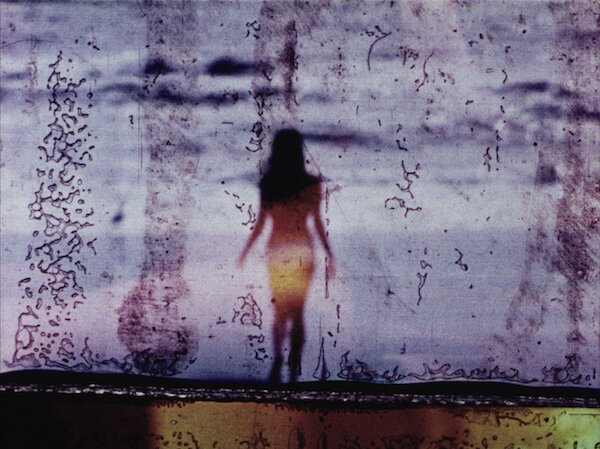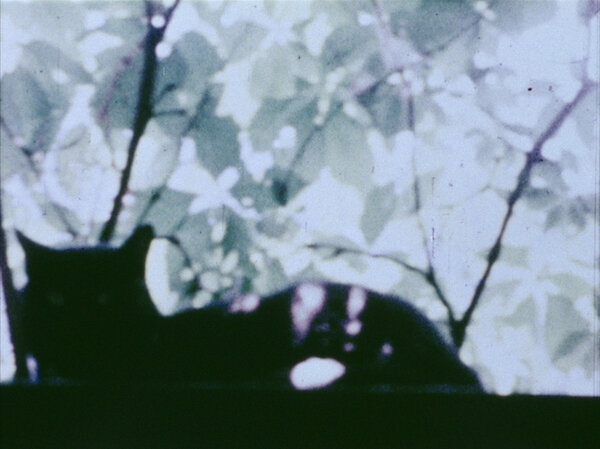Carolee Schneemann found beauty and the erotic in domestic spaces like no one else. Her work, too, uses fragmented narratives which echo our contemporary pandemic time – mirroring our own lives while asking probing questions about our relationship to space, time and intimacy that will always be relevant. Jennifer Irving explores Schneemann’s singular filmmaking in Fuses and Kitch’s Last Meal.
Global pandemics aside, it’s surprisingly hard to find a video player these days.
I possess one copy of Carolee Schneemann’s film Fuses (1964-66), a video cassette in a clear case, smuggled out of a university library that I did not attend by a friend with a grudge that needed flexing. I watched it in another library, belonging to a university that I did attend. The edge of the desk cut into my shins, knees drawn to my chest, my lower back aching, as I watched on the old TV under fluorescent lighting.
Carolee Schneemann was a multidisciplinary artist whose work spanned film, painting, performance, text and all the ephemera that lay between. She began making work in the 1960s, often focusing on sexuality and the construction of gender; characteristic of second wave feminism, Schneemann places her own body as central to understanding larger themes. In Fuses, Schneemann films herself having sex with her partner, James Tenney. Filmed over a three-year period, assumptive pornographic or phallocentric narrative structures of heterosexual sex are disrupted through collaging and splicing the film footage away from easy recognition.
Schneemann’s work bubbled and bloomed on the screen. Bodies glimpsed between the scratched, stained and cut film. In my notes from my first viewing, I described it as like watching the inside of a mouth, all lurid reds and soft blues. Rather than privileging orgasm, each touch – whether a kiss, a graze of the thigh, arm – exudes eroticism. This erotic potential extends beyond sex, beyond Schneemann and Tenney’s bodies. Schneemann interweaves the footage with that of her house, landscapes, a visit to the beach and her cat, Kitch. Intimacy explodes beyond known somatic and temporal boundaries, found in everything she and her camera touch.
Rather than objectively document events to be manipulated in post-production, Schneemann’s camera becomes an active agent in the work. Schneemann and Tenney shared filming duties, possibly hand-holding or fixing the camera to lights or nearby tables. The camera shifts in and out of focus, responding to its environment and the touch of others – it becomes difficult to tell whether the pulsing onscreen is a body, or the camera impacted by a body. Just as Kitch the cat becomes another presence through which to view Schneemann’s subject, the camera’s objective gaze is disrupted by the very touch it seeks to capture. The male gaze and heteronormative presumptions are thwarted, but so are Schneemann’s and Kitch’s. Critic Dave McCullough’s 1968 review attributed a haptic objectivity to the work, recalling his viewing experience as ‘more like doing it than watching it…Fuses represents a complete fuck, not half a fuck.’ If anything, Fuses suggests the impossibility of a “complete fuck”; if the potential for eroticism can be found in every touch, human or otherwise, not only can sex never be fully known, arguably it could never end.
I found a second-hand VCR on Gumtree, fairly near to my parents’ house where I’ve been staying since September. The seller warns that it cannot rewind nor read the bottom of the tape; he sends me pictures of the white streaks that race along the lower third of the screen. Schneemann’s work often exists in multiple iterations, past performances and films projected over current work. Documentation and material traces of old work become instructions for new pieces become collaged artbooks for reproduction. I don’t think Schneemann would mind another reiteration – an old VCR, a cyborg collaborator, in a one-time performance.
In a performative lecture in 2011, Schneemann compared one of her childhood drawings, informally titled ‘The Exuberant Cat’ (1944), to a building construction passed in Liverpool while exhibiting at the Tate in 2009. Schneemann indiscriminately finds connections that cross space and time, “This looks like this. This stems from this”, following a kind of haptic logic where art is reconfigured, less as a singular event or object, but as a way of knowing and connecting. While Schneemann’s work is indisputably characteristic of 20th century performance art in its focus on embodiment and immediacy, her approach to documentation feels generous in its insistence upon the potential for performance beyond her own bodily limits, extending to every being, object and thing that it touches.
In Schneemann’s later film, Kitch’s Last Meal (1973-8), Schneemann documents her cat Kitch’s final days while providing larger commentary on the contemporary art world. Domestic everyday scenes of cooking, cleaning, and painting (captured within the fixed duration of Super 8 film) rub against the feminist voicover, examining the New York art scene, the sexist and hypocritical actions of those who wield power within it and potential imaginings for a better one. Often Schneemann’s voiceover recounts conversations with “a happy man, a structuralist filmmaker”, who repeatedly dismisses Schneemann’s work for its “personal clutter,” “painterly mess,” and “diaristic indulgence”. At the beginning of the film, the sound of a train rushing past plays and resurfaces throughout the film. When the “happy man, a structuralist filmmaker” asks what her work is about, Schneemann responds:
– “My film is concerned with diet and digestion.”
– “Very well. Then why the train?”
– “The train is death and there is “diet” and “die” in digestion.”
– “Well then you’re back to metaphors and meanings.”
In the visual accompaniment to the conversation, Schneemann makes jam, carefully showing the whole process as she picks the berries, boils the jars and cans the jam, probably in preparation for the coming winter. The scene is framed via split screen, and on the dual side Schneemann paints a large expressionistic canvas. The dual films provide sardonic but synchronised commentary to the voiceover, as Schneemann holds her artistry and her domestic work in equal regard, co-constituting each other.
Contrary to the happy man’s insistence, Schneemann does not go “back” to metaphors. Her governing logic is one of instinct and intimacy (“This looks like this. This stems from this”) rather than historically and culturally endorsed sign systems. As in Fuses, there is almost a crass desire to touch and feel the subject intensely, to erotically engage with it in a way that reconfigures what the erotic could look like. Schneemann plays with the words in her mouth, just as she edits, cuts, scores and transforms her raw film footage beyond easy recognition. Yet, what could so easily be interpreted as destructive or chaotic proves to be as attentive as Schneemann’s care for her cat. The sound of trains, rather than signifying some grand onslaught of modernity or technological violence, becomes a grounding force, connecting images while preserving their heterogeneity. It doesn’t have to make sense to you, Schneemann seems to say, but it does to me right here right now – and that’s pretty hot. Schneemann disrupts patriarchal ways of organising knowledge, prioritising touch as a means to know over prevailing cultural systems that only perpetuate oppressive power structures.
There is a privilege in insisting that she can just shrug off context. In lockdown, I have become intimately aware that my life has been reduced to what lies within an arm’s reach. What and who I can touch carries less the possibility of connection and more the threat of harm. In Schneemann’s films, her house is almost as integral as her own body. Looking out at the world from her own property, Schneemann did not have to think about the repercussions of her touch or question its validity. The guarantee of a home and the guarantee of safety within it, allowed her to cross other structural barriers without repercussions. In Fuses, Schneemann and Tenney are silhouetted by the light coming through the window, their liberal approach to sex framed and sanctioned by it.
Schneemann’s work sought a better future for the world outside of patriarchal structures, through a logic of touch that not only exposed the necessity of domestic labour in making art, but insisted upon the value of both through subjecting them to scrutiny onscreen. She collages, overlaps, layers, probes and inserts footage of the quotidian into the artistic in a way that now tastes bittersweet. The pandemic has transformed understandings of public and private space, restricting access to the former while incessantly occupying the latter. The natural pauses in space and time between work, rest and pleasure have been erased – or at least compiled into 50 different tabs on my browser. I flick between them, unable to fully focus or fully relax, tech giants profiting from my inability to ever fully look away. While Schneemann’s collaged and transformed film footage centres processes of time and labour, I cannot think within the four corners of my screen.
I leave my room and try to set up the VCR downstairs, a bouquet of red, yellow and white cables that feel vaguely familiar, but try as I might, I cannot connect the two. I had previously searched online for a copy of Fuses, albeit reluctantly, but it looked like there was little choice left. There’s a copy on Youtube, it’s more of a video essay, someone else’s commentary plays over the top. I watch it while I change my bedsheets before a work call in an hour.
Jennifer Irving (@jennifirv) is a writer currently based in South England. She organises with the Hackney-based charity Xenia, working as a workshop facilitator, and running their social medias (@XeniaWomen). She is particularly interested in writing about disability, neurodivergence, queerness, miscommunication, inarticulacy, and touch, as well as working with community-based practices.



